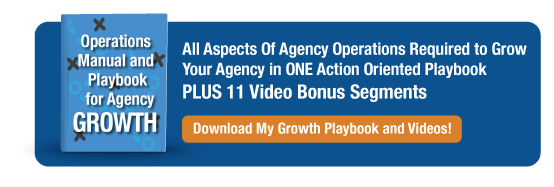 When we started Square 2, almost 17 years ago, we were smart enough to know that doing projects for clients was not going to get them the results they expected from an investment in marketing. Fast forward to 2019 and now the 12-month retainer engagement is not getting clients the results they expected either.
When we started Square 2, almost 17 years ago, we were smart enough to know that doing projects for clients was not going to get them the results they expected from an investment in marketing. Fast forward to 2019 and now the 12-month retainer engagement is not getting clients the results they expected either.
How is that possible? Everyone told you to sign up clients for ongoing, retainer engagements to balance out cash flow, create long term relationships with clients and help you build your agencies.
But 12-month retainer engagements don’t do anything to get clients what they want—FAST RESULTS. Do you know any clients who don’t want fast results? Right, I don’t either.
Here’s what 12-month retainers are designed to do and what’s fundamentally broken with them.
Designed To Delay
First, retainers stretch out everything the client needs to do over the 12-month period delaying your ability to get clients results faster and forcing the client to be patient. This also means your client services team has to meter out what you do for clients based on their budget assigned by the retainer.
I understand that this is arbitrary, based on the client’s budget. When they can only afford to do $5,000 a month, you can only do so much and if they could afford to invest $10,000, you could do more.
I get that but the results are the same. You’re not doing everything you could do when you could do it and by design, you’re stretching out the work to fit the budget – retarding the client’s results.
I'm not placing blame. It's a shared failure. Failure on the client side for limiting by under investing and on the agency side by agreeing to a slow rollout of what's needed to produce results.
It's also not nefarious in any way. I know agencies are doing their best to help clients with limited budgets, limited knowledge and limited resources. The retainer is not designed to produce results, it's designed to manage the client's budget.
Inherently Inefficient
You have your client services team and your consultants and you’re trying to find ways to give them the ability to handle more and more clients. The more clients they handle, the more money you make. I understand this intimately, after all, I created the Hive/Pod model so many agencies run today.
But this requires your consultants to handle between 5 and 15 clients. The lower your retainers, the more clients your consultants have to handle. This means your people are jumping from one client to another three or four times a day. This is highly inefficient.
In fact, research indicates up to 40 percent of productivity could be lost due to task-switching. It actually takes more time to complete the tasks you're switching between and you make more errors than when you focus on doing one task at a time in order.
A Stanford study confirmed this by showing that those who multitask are indeed worse performers, and struggle because they can't filter out irrelevant information, slowing down completion of the cognitive task at hand.
Additionally, studies have shown that it takes four times longer for the brain to recognize new things (further slowing down task completion) and that we have a much lower retention rate of what we learn while we are multitasking.
Working on and for three or four clients a day is actually highly inefficient.
Challenging To Maintain Momentum
Do you remember how exciting that new client kick off was the other day? Your team was excited, your client was excited, the meeting was filled with ideas and expectations. Think about that same group of people meeting again in three months or six months. What is that meeting going to be like?
It’s extremely challenging to maintain excitement and momentum with long term engagements. It’s hard for the client to keep up with us. It’s hard for them to remember everything we’ve done. It’s even hard for them to remember what their results were before we came along.
Generally, it’s “what have you done for me lately and what else can you do to produce better results.” And these are the best relationships. The mediocre engagements might include finger pointing and some negative energy. Who can blame them, revenue growth takes time, patience and it’s hard to hit a home run every month for every client?
I could probably go on, talking about what’s wrong with the traditional retainer engagement. David A. Baker has a similar opinion. He discusses it in detail here if you're interested.
Here’s an alternative that might be exactly what we need in the agency community.
Dedicated Team
The only reason you can’t do more for clients and get them faster results is because your client services team is only working for that client part-time. If they have six clients, they’re spending 1/6 of their week on any one client. Meaning it’s going to take them six times as long to generate results than if they were only working on one client.
This is one of the reasons behind the trend for companies to hire in-house. They have the same tools, the same strategy, the same tactics as we do but their dedicated teams get to focus on ONLY their company.
Agencies should be able to do something similar.
When you hire Deloitte or Accenture, do they give you a team working on six or 10 other clients? Nope. They give you a team that is ONLY working on your business. In some cases, they set up shop in your office and they’re there every day until the job is done.
We should be able to do the same. A dedicated team can get six months’ worth of work done in just 30 days.
Agile Delivery
If you run your agency on Agile, and you should, you’ve already learned that the traditional Agile Scrum approach doesn’t work perfectly in the agency environment and you need to make modifications. Some of the challenges include; the client not being part of the team, having to share resources across teams, the client impacting the schedule and the general flow of work through the agency.
We’ve made a number of adjustments over the years to make Agile work at Square 2.
When you provide a dedicated team, working on just one client for a shorter period of team, Agile works exactly as designed. No shared resources, the client is engaged daily, there is no client inspired negative impact on timelines and a weekly Sprint works perfectly.
Highly Efficient
Just think about your team working on one client for one month. No jumping between clients, industries, personalities, and competing priorities. How well do you think your team would get to know their clients? How strong would those relationships become? This is the kind of engagement relationship we all pine for.
The team is working all day, every day on a single client. The client is getting stuff done. The results are coming in faster than the expected and the team is intimate with the client, their business, their people and their industry. It’s the type of relationship we should have with all our clients.
The team has no conflicting priorities. They focus on one single client. They’re not distracted, they don’t shift gears mid-day or have to manage to keep multiple balls in the air at the same time for multiple clients.
The gains in efficiency are massive. The results you can deliver for your clients in days instead of months is game-changing.
The Right Clients
This type of engagement is not for everyone. It’s not for the CEO who also runs marketing and sales. It’s not for a client who wants to go slow (for whatever reason). It’s not for a client who doesn’t value marketing or sales enablement and who is reluctant to invest in it.
Instead, it is perfect for clients who meet the psychographic profile of the perfect client. They have someone or a team dedicated to marketing and revenue growth. They just need help to be more effective and produce better results.
It’s perfect for a client who is comfortable investing in marketing and sales enablement to impact revenue results quickly, in weeks, not months or years.
They want to work with us, as a team and share in the ownership of the execution and the results.
It’s perfect for a client who understands what goes into producing good work that is connected with a strategy and an orchestrated set of tactics.
This type of engagement gives us a better chance to steer away from the bad clients and focus on the best clients.
Happier Team Members
If we’re honest with ourselves, as agency owners, the people managing our clients could be happier. Most people don’t like worrying about whether a client is happy or not. Most people don’t look forward to a call where clients want to know why we’re not getting better results. Most people get bored working with the same mediocre clients for month after month.
Worse, most people get frustrated when we’ve done everything we can do, the client is seeing good results and they’re still not happy, won’t be a reference or won’t give us a nice pat on the back. How demoralizing.
But in 30 days, you can focus, get clients results, build an amazing relationship, and finally marry results with a dramatically reduced timeline to make everyone ecstatic at the end of the engagement. Now the reviews are easy, the references flow and the referrals make adding new clients on this type of engagement easy.
It’s the agency we all thought we were going to have. The key now is figuring out how to deliver a dedicated team to every single client.
 Start Today Tip – You don’t have to be Deloitte to deliver a dedicated team to your clients. Anyone can do it. Do you remember when you had to wait around all day for the plumber to show up? Today a good plumber says they’ll be there at 2PM, they text you when they’re on their way and call you when they’re five minutes out. It’s definitely doable. In fact, the results are so dramatic and positive that everyone has to work to figure out how to deliver a dedicated team. Start looking at this now, it's going to take you a few months to figure it out, try to sell it, get your first client and deliver your first engagement. From there you’ll learn a ton about what to do differently with client two.
Start Today Tip – You don’t have to be Deloitte to deliver a dedicated team to your clients. Anyone can do it. Do you remember when you had to wait around all day for the plumber to show up? Today a good plumber says they’ll be there at 2PM, they text you when they’re on their way and call you when they’re five minutes out. It’s definitely doable. In fact, the results are so dramatic and positive that everyone has to work to figure out how to deliver a dedicated team. Start looking at this now, it's going to take you a few months to figure it out, try to sell it, get your first client and deliver your first engagement. From there you’ll learn a ton about what to do differently with client two.
Agencies 2 Inbound – Helping You Grow Your Agency Beyond Your Expectations!


